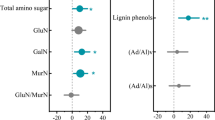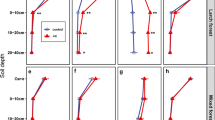Abstract
Background
Dry seasonal ecosystems such as the Florida sandhill are defined by a pronounced and consistent dry season that results in both water and nutrient limitation. Deciduous and evergreen species have evolved different leaf phenologies, which change the temporal pattern of nutrient demands for leaf growth.
Methods
To measure N uptake for deciduous and evergreen species during late dry season deciduous leaf-out, we labeled the shallow soil with 15N by spreading a mixture of native sand and 15N-KNO3 around each tree and measured foliar nitrogen isotopic composition. We also measured foliar N content and nitrogen resorption efficiency (NRE).
Results
Evergreen and deciduous species were not consistently different in foliar N content and NRE, but natural foliar δ15N values were consistently higher in deciduous species. Labeling experiments show that uptake rate of 15N- labeled NO3 − was lowest for the deciduous species.
Conclusions
Inconsistent results in foliar N content and NRE do not explain the differences in leaf habit in nutrient-poor ecosystems. Low N uptake during leaf-out limits deciduous species to the most fertile regions of the Florida scrub as well as in several other ecosystems, so that they can take up sufficient N to meet the demands of leaf growth.





Similar content being viewed by others
References
Abrahamson WG, Johnson AF, Layne JN, Peroni P (1984) Vegetation of the Archbold Biological Station, Florida: an example of the southern Lake Wales ridge. Fla Sci 47:209–250
Aerts R (1990) Nutrient use efficiency in evergreen and deciduous species from heathlands. Oecologia 84:391–397
Aerts R (1995) The advantages of being evergreen. Trends Ecol Evol 10:402–407
Aerts R (1996) Nutrients resorption from senescing leaves of perennials: are there general patterns? J Ecol 84:597–608
Aerts R, Van der Peijl M (1993) A simple model to explain the dominance of low-productive perennials in nutrient-poor habitats. Oikos 66:144–147
Anderson R, Menges E (1997) Effects of fire on sandhill herbs: nutrients, mycorrhizae, and biomass allocation. Am J Bot 84:938–948
Ares A, Gleason SM (2007) Foliar nutrient resorption in tree species. In: Scaggs AK (ed) New research on forest ecology. Nova Science Publishers, New York City, pp. 1–32
Armitage P (1980) Statistical Methods in Medical Research. Blackwell Scientific Publications, Oxford UK
Bai E, Boutton TW, Liu F, Wu XB, Archer SR, Hallmark CT (2009) Spatial variation of the stable nitrogen isotope ratio of woody plants along a topoedaphic gradient in a subtropical savanna. Oecologia 159:493–503
Bazzaz F (1979) The physiological ecology of plant succession. Annu Rev Ecol Syst 10:351–371
Beadle NCW (1968) Some aspects of the ecology and physiology of Australian xeromorphic plants. Aust J Sci 30:348–355
Berendse F (1994) Litter decomposability–a neglected component of plant fitness. J Ecol 82:187–190
Boerner R (1984) Foliar nutrient dynamics and nutrient use efficiency of four deciduous tree species in relation to site fertility. J Appl Ecol 21:1029–1040
Chabot BF, Hicks DJ (1982) The ecology of leaf life spans. Annual Review of Ecological Systems 13:229–259
Chapin FS (1980) The mineral nutrition of wild plants. Annu Rev Ecol Syst 11:233–260
Chapin FS (1983) Nitrogen and phosphorus nutrition and nutrient cycling by evergreen and deciduous understory shrubs in an Alaskan black spruce forest. Can J For Res 13:773–781
Chapin FS, Johnson DA, McKendrick JD (1980) Seasonal movement of nutrients in plants of differing growth form in an Alaskan tundra ecosystem: implications for herbivory. J Ecol 68:189–209
Coley PD, Bryant JP, Chapin III FS (1985) Resource availability and plant antiherbivore defense. Science 230:895–899
Del Arco JM, Escudero A, Garrido MV (1991) Effects of site characteristics on nitrogen retranslocation from senescing leaves. Ecology 72:701–708
Eckstein RL, Karlsson PS, Weih M (1999) Research review: Leaf life span and nutrient resorption as determinants of plant nutrient conservation in temperate-Arctic regions. New Phytol 143:177–189
Ellsworth PZ, Sternberg LS (2014) Seasonal water use by deciduous and evergreen woody species in a scrub community is based on water availability and root distribution. Ecohydrology. doi:10.1002/eco.1523
Emmerton KS, Callaghan TV, Jones HE, Leake JR, Michelsen A, Read DJ (2001) Assimilation and isotopic fractionation of nitrogen by mycorrhizal and nonmycorrhizal subarctic plants. New Phytol 151:513–524
Escudero A, Del Arco J, Sanz I, Ayala J (1992) Effects of leaf longevity and retranslocation efficiency on the retention time of nutrients in the leaf biomass of different woody species. Oecologia 90:80–87
Evans RD (2001) Physiological mechanisms influencing plant nitrogen isotope composition. Trends Plant Sci 6:121–126
Farquhar GD, Firth PM, Wetselaar R, Weir B (1980) On the gaseous exchange of ammonia between leaves and the environment: Determination of the ammonia compensation point. Plant Physiol 66:710–714
Gebauer RLE, Ehleringer JR (2000) Water and nitrogen uptake patterns following moisture pulses in a cold desert community. Ecology 81:1415–1424
Gray JT (1983) Nutrient use by evergreen and deciduous shrubs in southern California. J Ecol 71:21–41
Handley L, Austin A, Stewart G, Robinson D, Scrimgeour C, Raven J, Schmidt S (1999) The 15N natural abundance (δ15N) of ecosystem samples reflects measures of water availability. Funct Plant Biol 26:185–199
Hartman G, Danin A (2010) Isotopic values of plants in relation to water availability in the Eastern Mediterranean region. Oecologia 162:837–852
Hobbie E, Hobbie J (2008) Natural abundance of 15 N in nitrogen-limited forests and tundra can estimate nitrogen cycling through mycorrhizal fungi: a review. Ecosystems 11:815–830
Hobbie EA, Macko SA, Shugart HH (1999) Interpretation of nitrogen isotope signatures using the NIFTE model. Oecologia 120:405–415
Hobbie EA, Jumpponen A, Trappe J (2005) Foliar and fungal 15N:14N ratios reflect development of mycorrhizae and nitrogen supply during primary succession: testing analytical models. Oecologia 146:258–268
Huang J, Wang X, Yan E (2007) Leaf nutrient concentration, nutrient resorption and litter decomposition in an evergreen broad-leaved forest in eastern China. For Ecol Manag 239:150–158
Huck RB (1987) Plant communities along an edaphic continuum in a central Florida watershed. Florida Scientist 50:112–128
Kalisz PJ, Stone EL (1984) The longleaf pine islands of the Ocala National Forest, Florida: a soil study. Ecology 65:1743–1754
Kao W, Tsai H, Shih C, Tsai T, Handley LL (2002) Nutrient contents, d13C and d15N during leaf senescence in the mangrove. Kandelia Candel (L) Druce Botanical Bulletin of Academia Sinica 43:277–282
Kikuzawa K (1991) A cost-benefit analysis of leaf habit and leaf longevity of trees and their geographical pattern. Am Nat 138:1250–1263
Killingbeck KT (1996) Nutrients in senesced leaves: keys to the search for potential resorption and resorption proficiency. Ecology 77:1716–1727
Kranabetter J, MacKenzie W (2010) Contrasts among mycorrhizal plant guilds in foliar nitrogen concentration and δ15N along productivity gradients of a boreal forest. Ecosystems 13:108–117
Lal C, Annapurna C, Raghubanshi A, Singh J (2001) Effect of leaf habit and soil type on nutrient resorption and conservation in woody species of a dry tropical environment. Can J Bot 79:1066–1075
Lloyd J, Goulden M, Ometto J, Patiño S, Fyllas N, Quesada C (2009) Ecophysiology of forest and savanna vegetation. Geogr Monogr Ser 186:463–484
Lodge DJ, McDowell WH, McSwiney CP (1994) The importance of nutrient pulses in tropical forests. Trends Ecol Evol 9:384–387
Luizao RCC, Bonde TA, Rosswall T (1992) Seasonal variation of soil microbial biomass—the effects of clearfelling a tropical rainforest and establishment of pasture in the Central Amazon. Soil Biol Biochem 24:805–813
Marschner H, Dell B (1994) Nutrient uptake in mycorrhizal symbiosis. Plant Soil 159:89–102
Menges ES (1999) Ecology and conservation of Florida scrub. In: Anderson RC, Fralish JS, Baskin JM (eds) Savannas, barrens, and rock outcrop plant communities of North America. Cambridge University Press, Cambridge, pp. 7–22
Menges ES, Gallo NP (1991) Water relations of scrub oaks on the Lake Wales Ridge, Florida. Florida Scientist 54:69–79
Michelsen A, Schmidt IK, Jonasson S, Quarmby C, Sleep D (1996) Leaf 15N abundance of subarctic plants provides field evidence that ericoid, ectomycorrhizal and non-and arbuscular mycorrhizal species access different sources of soil nitrogen. Oecologia 105:53–63
Miller H, Cooper JM, Miller J (1976) Effect of nitrogen supply on nutrients in litter fall and crown leaching in a stand of Corsican pine. J Appl Ecol 13:233–248
Mills HA, Barker AV, Maynard DN (1974) Ammonia volatilization from soils. Agron J 66:355–358
Monk CD (1966) An ecological significance of evergreenness. Ecology 47:504–505
Murphy PG, Lugo AE (1986) Ecology of tropical dry forest. Annual Review of Ecological Systems 17:67–88
Nardoto GB, da Cunha Bustamante MM, Pinto AS, Klink CA (2006) Nutrient use efficiency at ecosystem and species level in savanna areas of central Brazil and impacts of fire. J Trop Ecol 22:191–201
Nordell K, Karlsson P (1995) Resorption of nitrogen and dry matter prior to leaf abscission: variation among individuals, sites and years in the mountain birch. Funct Ecol 9:326–333
Pornon A, Marty C, Winterton P, Lamaze T (2011) The intriguing paradox of leaf lifespan responses to nitrogen availability. Funct Ecol 25:796–801
R Core Team (2013) R: A Language and Environment for Statistical Computing
Raghubanshi AS, Srivastava SC, Singh RS, Singh JS (1990) Nutrient release in leaf litter. Nature (London) 346:227–227
Robinson D (2001) δ15N as an integrator of the nitrogen cycle. Trends Ecol Evol 16:153–162
Saha S, Strazisar TM, Menges ES, Ellsworth P, Sternberg L (2008) Linking the patterns in soil moisture to leaf water potential, stomatal conductance, growth, and mortality of dominant shrubs in the Florida scrub ecosystem. Plant Soil 313:113–127
Schmidt S, Stewart G (2003) δ15N values of tropical savanna and monsoon forest species reflect root specialisations and soil nitrogen status. Oecologia 134:569–577
Silva LC, Anand M (2011) Mechanisms of Araucaria (Atlantic) forest expansion into southern Brazilian grasslands. Ecosystems 14:1354–1371
Singh J, Raghubanshi A, Singh R, Srivastava S (1989) Microbial biomass acts as a source of plant nutrients in dry tropical forest and savanna. Nature 338:499–500
Sokal RR, Rohlf FJ (1995) Biometry: the principles and practice of statistics in biological research. W. H. Freeman and Co., New York
Sorrell BK, Chagué-Goff C, Basher LM, Partridge TR (2011) N: P ratios, δ15N fractionation and nutrient resorption along a nitrogen to phosphorus limitation gradient in an oligotrophic wetland complex. Aquat Bot 94:93–101
Stephens EL, Saha S, Menges ES (2009) Intracanopy variation in leaf morphology and physiology in dominant shrubs of Florida's xeric uplands. Botany 87:112–125
Turner J, Olson P (1976) Nitrogen relations in a Douglas-fir plantation. Ann Bot 40:1185–1193
Weekley CW, Gagnon D, Menges ES, Quintana-Ascencio PF, Saha S (2007) Variation in soil moisture in relation to rainfall, vegetation, gaps, and time-since-fire in Florida scrub. Ecoscience 14:377–386
Weekley CW, Menges ES, Pickert RL (2008) An ecological map of Florida's Lake Wales Ridge: a new boundary delineation and an assessment of post-Columbian habitat loss. Fla Sci 71:45–64
Welker JM, Jónsdóttir IS, Fahnestock JT (2003) Leaf isotopic (δ13C and δ15N) and nitrogen contents of Carex plants along the Eurasian Coastal Arctic: results from the Northeast Passage expedition. Polar Biol 27:29–37
Acknowledgments
The authors thank Archbold Biological Station for allowing access to the Florida sandhill to conduct this research. Thanks to Patricia V. Ellsworth for assistance in field work and to Sonali Saha for reviewing this manuscript and giving insight and comments on how to improve it.
Author information
Authors and Affiliations
Corresponding author
Additional information
Responsible Editor: Ad C. Borstlap.
Rights and permissions
About this article
Cite this article
Ellsworth, P.Z., Sternberg, L.S.L. Strategies in nitrogen uptake and use by deciduous and evergreen woody species in a seasonally dry sandhill community. Plant Soil 400, 165–175 (2016). https://doi.org/10.1007/s11104-015-2715-y
Received:
Accepted:
Published:
Issue Date:
DOI: https://doi.org/10.1007/s11104-015-2715-y




